
Auto Union
Encyclopedia
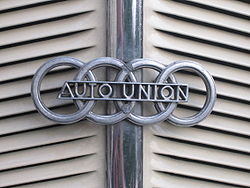
_.jpg)

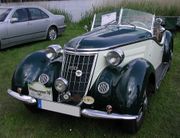
Germany
Germany , officially the Federal Republic of Germany , is a federal parliamentary republic in Europe. The country consists of 16 states while the capital and largest city is Berlin. Germany covers an area of 357,021 km2 and has a largely temperate seasonal climate...
automobile
Automobile
An automobile, autocar, motor car or car is a wheeled motor vehicle used for transporting passengers, which also carries its own engine or motor...
manufacturers, founded in 1932 and established in 1936 in Chemnitz
Chemnitz
Chemnitz is the third-largest city of the Free State of Saxony, Germany. Chemnitz is an independent city which is not part of any county and seat of the government region Direktionsbezirk Chemnitz. Located in the northern foothills of the Ore Mountains, it is a part of the Saxon triangle...
, Saxony
Saxony
The Free State of Saxony is a landlocked state of Germany, contingent with Brandenburg, Saxony Anhalt, Thuringia, Bavaria, the Czech Republic and Poland. It is the tenth-largest German state in area, with of Germany's sixteen states....
, during the Great Depression
Great Depression
The Great Depression was a severe worldwide economic depression in the decade preceding World War II. The timing of the Great Depression varied across nations, but in most countries it started in about 1929 and lasted until the late 1930s or early 1940s...
. The company has evolved into present day Audi
Audi
Audi AG is a German automobile manufacturer, from supermini to crossover SUVs in various body styles and price ranges that are marketed under the Audi brand , positioned as the premium brand within the Volkswagen Group....
, as a subsidiary of Volkswagen Group
Volkswagen Group
Volkswagen Group is a German multinational automobile manufacturing group. , Volkswagen was ranked as the world’s third largest motor vehicle manufacturer and Europe's largest....
.
Auto Union is widely known for its racing team (Auto Union Rennabteilung, based at Horch
Horch
Horch was a car brand manufactured in Germany by August Horch & Cie, at the beginning of the 20th century.-History at a Glance:The company was established first by August Horch and his first business partner Salli Herz on November 14, 1899 at Ehrenfeld, Cologne. August Horch was a former production...
works in Zwickau
Zwickau
Zwickau in Germany, former seat of the government of the south-western region of the Free State of Saxony, belongs to an industrial and economical core region. Nowadays it is the capital city of the district of Zwickau...
/Saxony
Saxony
The Free State of Saxony is a landlocked state of Germany, contingent with Brandenburg, Saxony Anhalt, Thuringia, Bavaria, the Czech Republic and Poland. It is the tenth-largest German state in area, with of Germany's sixteen states....
). The Silver Arrows
Silver Arrows
Silver Arrows was the name given by the press to Germany's dominant Mercedes-Benz and Auto Union Grand Prix motor racing cars between 1934 and 1939, and also later applied to the Mercedes-Benz Formula One and sports cars in 1954/55.For decades until the introduction of sponsorship liveries, each...
of these two German teams (Mercedes-Benz
Mercedes-Benz
Mercedes-Benz is a German manufacturer of automobiles, buses, coaches, and trucks. Mercedes-Benz is a division of its parent company, Daimler AG...
and Auto Union) dominated not only GP car racing from 1934 onwards, but set records that would take decades to beat. For example, the power levels of the unlimited 1937 models were only equalled in the early 1980s by turbocharged Formula One
Formula One
Formula One, also known as Formula 1 or F1 and referred to officially as the FIA Formula One World Championship, is the highest class of single seater auto racing sanctioned by the Fédération Internationale de l'Automobile . The "formula" designation in the name refers to a set of rules with which...
Grand Prix cars.
Formation
Auto Union was formed in 1932, merging:- AudiAudiAudi AG is a German automobile manufacturer, from supermini to crossover SUVs in various body styles and price ranges that are marketed under the Audi brand , positioned as the premium brand within the Volkswagen Group....
- having fallen out with family member, August Horch founded Audi in ZwickauZwickauZwickau in Germany, former seat of the government of the south-western region of the Free State of Saxony, belongs to an industrial and economical core region. Nowadays it is the capital city of the district of Zwickau...
1909, which built inline-four, six and eight cylinder engined cars. - DKWDKWDKW is a historic German car and motorcycle marque. The name derives from Dampf-Kraft-Wagen .In 1916, the Danish engineer Jørgen Skafte Rasmussen founded a factory in Zschopau, Saxony, Germany, to produce steam fittings. In the same year, he attempted to produce a steam-driven car, called the DKW...
- steam equipment company founded by DanishDenmarkDenmark is a Scandinavian country in Northern Europe. The countries of Denmark and Greenland, as well as the Faroe Islands, constitute the Kingdom of Denmark . It is the southernmost of the Nordic countries, southwest of Sweden and south of Norway, and bordered to the south by Germany. Denmark...
engineer Jørgen Skafte RasmussenJørgen Skafte RasmussenJørgen Skafte Rasmussen was an engineer and industrialist of Danish origin. He moved to Germany and established several automobile and motorcycle manufacturing companies, including DKW and Framo. Rasmussen acquired a majority interest in Audi in 1928, which four years later became Auto Union...
in 1916, it branched out into motorcycles, and then front-drive two-stroke cars built at Audi works in ZwickauZwickauZwickau in Germany, former seat of the government of the south-western region of the Free State of Saxony, belongs to an industrial and economical core region. Nowadays it is the capital city of the district of Zwickau...
since 1931. - HorchHorchHorch was a car brand manufactured in Germany by August Horch & Cie, at the beginning of the 20th century.-History at a Glance:The company was established first by August Horch and his first business partner Salli Herz on November 14, 1899 at Ehrenfeld, Cologne. August Horch was a former production...
- founded by August HorchAugust HorchAugust Horch was a German engineer and automobile pioneer, the founder of the manufacturing giant which would eventually become Audi.-Beginnings:...
in ZwickauZwickauZwickau in Germany, former seat of the government of the south-western region of the Free State of Saxony, belongs to an industrial and economical core region. Nowadays it is the capital city of the district of Zwickau...
1904, it built cars starting from straight-2 engines to luxury models with V8-V8 engineA V8 engine is a V engine with eight cylinders mounted on the crankcase in two banks of four cylinders, in most cases set at a right angle to each other but sometimes at a narrower angle, with all eight pistons driving a common crankshaft....
and V12 engineV12 engineA V12 engine is a V engine with 12 cylinders mounted on the crankcase in two banks of six cylinders, usually but not always at a 60° angle to each other, with all 12 pistons driving a common crankshaft....
s. - WandererWanderer (car)Wanderer was a German manufacturer of bicycles, motorcycles, automobiles, vans and other machinery. Established as Winklhofer & Jaenicke in 1896, the company used the Wanderer brand name from 1911, making civilian automobiles until 1941 and military vehicles until 1945.-History:Winklhofer &...
- founded in 1911, with small four-cylinder cars and later a more luxurious V6 built in Siegmar (nowadays ChemnitzChemnitzChemnitz is the third-largest city of the Free State of Saxony, Germany. Chemnitz is an independent city which is not part of any county and seat of the government region Direktionsbezirk Chemnitz. Located in the northern foothills of the Ore Mountains, it is a part of the Saxon triangle...
)
In August 1928, Rasmussen, the owner of DKW, acquired the majority of shares in Audiwerke AG. In the same year, Rasmussen bought the remains of the US automobile manufacturer Rickenbacker
Rickenbacker (car)
Rickenbacker Motor Company was a US automobile manufacturer based in Detroit, Michigan from 1922 until 1928.The company was established by Eddie Rickenbacker , America's leading fighter ace during World War I. He used his World War I 94th Fighter Squadron emblem depicting a top hat inside a ring...
, including the manufacturing equipment for eight cylinder engines. These engines were used in Audi Zwickau, Audi Imperator and Audi Dresden models that were launched in 1929. At the same time, six cylinder and four cylinder (licensed from Peugeot
Peugeot
Peugeot is a major French car brand, part of PSA Peugeot Citroën, the second largest carmaker based in Europe.The family business that precedes the current Peugeot company was founded in 1810, and manufactured coffee mills and bicycles. On 20 November 1858, Emile Peugeot applied for the lion...
) models were manufactured.
In 1932, with all companies still losing money, Audi/DKW, Horch and Wanderer were brought together under the umbrella of communal shareholder
Shareholder
A shareholder or stockholder is an individual or institution that legally owns one or more shares of stock in a public or private corporation. Shareholders own the stock, but not the corporation itself ....
company Auto Union. Although all four brands continued to build cars under their own names and brands, the technological development became more and more centralized, with some Audi models employing engines by Horch or Wanderer.
Background
Auto Union Chairman, Klaus, Baron von OertzenKlaus von Oertzen
Baron Claus-Detlof von Oertzen was involved in the motor industry for most of his long life and is sometimes referred to as the “Father of Volkswagen of South Africa”....
, wanted a show piece project to announce the new brand. At the 1933 Berlin Motor Show, German Chancellor Adolf Hitler
Adolf Hitler
Adolf Hitler was an Austrian-born German politician and the leader of the National Socialist German Workers Party , commonly referred to as the Nazi Party). He was Chancellor of Germany from 1933 to 1945, and head of state from 1934 to 1945...
announced two new programs:
- The people's car: a project that became the KdF carVolkswagen BeetleThe Volkswagen Type 1, widely known as the Volkswagen Beetle or Volkswagen Bug, is an economy car produced by the German auto maker Volkswagen from 1938 until 2003...
- A state-sponsored motor racing programme: to develop a "high speed German automotive industry," the foundation of which would be an annual sum of 500,000 Reichmarks to Mercedes-BenzMercedes-BenzMercedes-Benz is a German manufacturer of automobiles, buses, coaches, and trucks. Mercedes-Benz is a division of its parent company, Daimler AG...
At fellow director's Adolf Rosenberger
Adolf Rosenberger
Adolf Rosenberger was a successful businessman who mainly raced Mercedes and Benz cars in the 1920s. His successes and records included wins at Avus, Stuttgart Solitude in 1924 and 1925, the Kasseler Herkules Hillclimb and the Klausenpassrennen...
insistence, von Oertzen met with Dr. Ferdinand Porsche
Ferdinand Porsche
Ferdinand Porsche was an Austrian automotive engineer and honorary Doctor of Engineering. He is best known for creating the first hybrid vehicle , the Volkswagen Beetle, and the Mercedes-Benz SS/SSK, as well as the first of many Porsche automobiles...
, who had done work for him before, and developed his own P-Wagen project racing car based on the new 750 kg (1,653.5 lb) formula.
German racing driver Hans Stuck Sr. had met Hitler before he became Chancellor, and not being able to gain a seat at Mercedes, accepted the invitation of Rosenberger to join him, von Oertzen, and Porsche in approaching the Chancellor. In a meeting in the Reich Chancellory, Hitler agreed with Porsche that for the glory of Germany, it would be better for two companies to develop the project, resulting in Hitler agreeing to pay ₤
Pound sterling
The pound sterling , commonly called the pound, is the official currency of the United Kingdom, its Crown Dependencies and the British Overseas Territories of South Georgia and the South Sandwich Islands, British Antarctic Territory and Tristan da Cunha. It is subdivided into 100 pence...
40,000 for the country's best racing car of 1934, as well as an annual stipend of 250,000 Reichmarks (₤20,000) each for Mercedes and Auto Union. (In time, this would climb to ₤250,000.) This highly annoyed Mercedes, who had already developed their Mercedes-Benz W25
Mercedes-Benz W25
The Mercedes-Benz W25 was a Grand Prix racing car designed by Daimler-Benz AG for the 1934 Grand Prix season, in which new rules were introduced, and no championship was held. In 1935, the European Championship was resumed, and it was won by Rudolf Caracciola in a W25...
, which nevertheless was gratified, its racing program having financial difficulties since 1931. It resulted in a heated exchange both on and off the racing track between the two companies until World War II.
Having garnered state funds, Auto Union bought Hochleistungs Motor GmbH and hence the P-Wagen Project for 75,000 Reichsmarks, relocating the company to Chemnitz
Chemnitz
Chemnitz is the third-largest city of the Free State of Saxony, Germany. Chemnitz is an independent city which is not part of any county and seat of the government region Direktionsbezirk Chemnitz. Located in the northern foothills of the Ore Mountains, it is a part of the Saxon triangle...
.
Design
The Auto Union racing cars types A to D were built as Grand PrixGrand Prix motor racing
Grand Prix motor racing has its roots in organised automobile racing that began in France as far back as 1894. It quickly evolved from a simple road race from one town to the next, to endurance tests for car and driver...
racing cars from 1934-1939. They resembled the earlier Benz Tropfenwagen, also built in part by Rumpler engineers), The only Grand Prix racers to wear Auto Union's four-ringed logo, they were particularly dominant in 1936. From 1935-1937, Auto Union cars car won 25 races, driven by Ernst von Delius
Ernst von Delius
Ernst von Delius was a racing driver from Germany.Von Delius died at the age of 25 years old at the Nürburgring Circuit during the 1937 German Grand Prix, having suffered a fatal collision with Richard Seaman....
, Bernd Rosemeyer
Bernd Rosemeyer
Bernd Rosemeyer was a German racing driver.- Career :...
, Hans Stuck Sr., and Achille Varzi
Achille Varzi
Achille Varzi , was an Italian Grand Prix driver.-Career:Born in Galliate, province of Novara , Achille Varzi was the son of a prosperous textile manufacturer...
. Much has been written about the difficult handling characteristics of this car, but its tremendous power and acceleration were undeniable — a driver could induce wheelspin at over 100 mph (160.9 km/h).
The cars used supercharged
Supercharger
A supercharger is an air compressor used for forced induction of an internal combustion engine.The greater mass flow-rate provides more oxygen to support combustion than would be available in a naturally aspirated engine, which allows more fuel to be burned and more work to be done per cycle,...
piston engines; eventually producing almost 550 hp, designed to provide optimum torque
Torque
Torque, moment or moment of force , is the tendency of a force to rotate an object about an axis, fulcrum, or pivot. Just as a force is a push or a pull, a torque can be thought of as a twist....
at low engine speeds. Rosemeyer would later drive one around the Nürburgring
Nürburgring
The Nürburgring is a motorsport complex around the village of Nürburg, Germany. It features a modern Grand Prix race track built in 1984, and a much longer old North loop track which was built in the 1920s around the village and medieval castle of Nürburg in the Eifel mountains. It is located about...
in a single gear, to prove the engine was flexible enough to do it. The fuel tank
Fuel tank
A fuel tank is safe container for flammable fluids. Though any storage tank for fuel may be so called, the term is typically applied to part of an engine system in which the fuel is stored and propelled or released into an engine...
was located in the centre of the car, directly behind the driver (who would be placed well towards the front), so the car's front-rear weight distribution would remain unchanged as fuel was used — exactly the same location used in modern open-wheel racing cars, and for the same reason. The chassis tubes were initially used as water carriers from the radiator to the engine, but this was eventually abandoned after they often sprung small leaks.
Racing results
The list of drivers for the initial 1934 season was headed by Stuck; he won the GermanGerman Grand Prix
The German Grand Prix is an annual automobile race.Because Germany was banned from taking part in international events after World War II, the German GP only became part of the Formula One World Championship in 1951...
, Swiss
Swiss Grand Prix
The Swiss Grand Prix was the premier auto race of Switzerland. In its later years it was a Formula One race....
, and Czechoslovakian
Czechoslovakian Grand Prix
The Czechoslovakian Grand Prix was a Grand Prix motor racing event first held on September 28, 1930 at the Masaryk Circuit now referred to as the Brno Circuit. It was held in the town of Brno in Czechoslovakia .From 1934 onwards, the race was dominated by the German Silver Arrows...
events, along with wins in a number of hill climbs, becoming European Mountain Champion.
In 1935, the engine had been enlarged to 5 l (305 cu in) displacement, producing 370 bhp. Achille Varzi
Achille Varzi
Achille Varzi , was an Italian Grand Prix driver.-Career:Born in Galliate, province of Novara , Achille Varzi was the son of a prosperous textile manufacturer...
joined the team and won the Tunis Grand Prix and the Coppa Acerbo
Coppa Acerbo
The Coppa Acerbo was an automobile race held in Italy, named after Tito Acerbo, the brother of Giacomo Acerbo, a prominent fascist politician. Following Italy's defeat in World War II, and the consequent demise of fascism, the race was renamed the Circuito di Pescara, and in some years was also...
. Stuck won the Italian Grand Prix, plus his usual collection of hill-climb wins, again taking the European Mountain Championship. The new sensation, Rosemeyer, won the Czech Grand Prix.
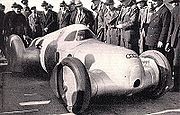
Mercedes-Benz T80
- External links :**, lists cars that attempted to break the land speed record from 1934 to 1940, including the T80.* at official website of European Car....
land speed record car.
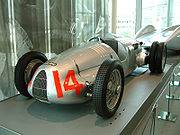
Eifelrennen
The ADAC Eifelrennen was an annual motor race, organised by ADAC Automobile Club from 1922 to 2003, held in Germany's Eifel mountain region even before the Nürburgring was built there.- History :...
, German, Swiss, and Italian Grands Prix, as well as the Coppa Acerbo. He was crowned European Champion (Auto Union's only win of the driver's championship), and also took the European Mountain Championship. Varzi won the Tripoli Grand Prix, while Stuck placed second in the Tripoli and German Grands Prix, and Ernst von Delius
Ernst von Delius
Ernst von Delius was a racing driver from Germany.Von Delius died at the age of 25 years old at the Nürburgring Circuit during the 1937 German Grand Prix, having suffered a fatal collision with Richard Seaman....
took second in the Coppa Acerbo.
In 1937, the car was basically unchanged and did surprisingly well against the new Mercedes-Benz W125
Mercedes-Benz W125
The Mercedes-Benz W125 was a Grand Prix racing car designed by Rudolf Uhlenhaut to race during the 1937 Grand Prix season. The car was used by Rudolf Caracciola to win the 1937 European Championship and W125 drivers also finished in the second, third and fourth positions in the championship.The...
, winning five races to the seven of Mercedes-Benz. Rosemeyer took the Eifel and Donington Grands Prix, the Coppa Acerbo, and the Vanderbilt Cup
Vanderbilt Cup
The Vanderbilt Cup was the first major trophy in American auto racing.-History:An international event, it was founded by William Kissam Vanderbilt II in 1904 and first held at a course set out in Nassau County on Long Island, New York. The announcement that the race was to be held caused...
. Rudolf Hasse
Rudolf Hasse
Rudolf Hasse was a famous German racing driver.Hasse was born in Mittweida, Saxony, and died while serving on the Russian front during World War II, aged only 36. He won the 1937 Belgian Grand Prix....
won the Belgian Grand Prix
Belgian Grand Prix
The Belgian Grand Prix is an automobile race, part of the Formula One World Championship....
.
In addition to the new 3 l (183 cu in) formula, 1938 brought other challenges, principally the death of Rosemeyer early in the year, in an attempt on the land speed record
Land speed record
The land speed record is the highest speed achieved by a wheeled vehicle on land. There is no single body for validation and regulation; in practice the Category C flying start regulations are used, officiated by regional or national organizations under the auspices of the Fédération...
on a German autobahn. The famed Tazio Nuvolari
Tazio Nuvolari
Tazio Giorgio Nuvolari was an Italian motorcycle and racecar driver, known as Il Mantovano Volante or Nivola. He was the 1932 European Champion in Grand Prix motor racing...
joined the team, and won the Italian and Donington Grands Prix, in what was otherwise a thin year for the team, other than yet another European Mountain Championship for Stuck.
In 1939, as war clouds gathered over Europe, Nuvolari won the Yugoslavia Grand Prix
1939 Belgrade City Race
The 1939 Belgrade City Race was a Grand Prix motor race held on September 3, 1939 at the streets of Belgrade.-Classification:-References:**...
in Belgrade, while Hermann P. Müller
Hermann Paul Müller
Hermann Paul Müller was a German sidecar, motorcycle, and race car driver....
won the 1939 French Grand Prix
1939 French Grand Prix
The 1939 French Grand Prix was a Grand Prix motor race held at Reims-Gueux on July 9, 1939.-Classification:...
.
Second World War
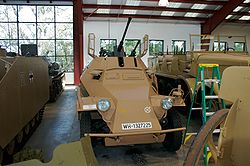
World War II
World War II, or the Second World War , was a global conflict lasting from 1939 to 1945, involving most of the world's nations—including all of the great powers—eventually forming two opposing military alliances: the Allies and the Axis...
encouraged the development and production of special vehicles for military purposes in the 1930s. Auto Union became an important supplier of vehicles to Germany's armed forces. Following the outbreak of war, civilian production was interrupted in May 1940. After this, the company produced exclusively for military purposes.
During World War II, Auto Union produced the Sd-Kfz 222 armored car. Powered by an 81 hp Horch/Auto Union V8 engine
V8 engine
A V8 engine is a V engine with eight cylinders mounted on the crankcase in two banks of four cylinders, in most cases set at a right angle to each other but sometimes at a narrower angle, with all eight pistons driving a common crankshaft....
, it reached a top speed of 50 mph (80.5 km/h) on the road. The Kraftfahrzeug 11 (KFZ 11), or Horch Type 80, was used as a light transport vehicle to shuttle German military officials.
The Auto Union plants were heavily bombed, and severely damaged by fighting in the last two years of the war. On 17 April 1945 in Zwickau, WWII ended with U.S. Army occupation. After withdrawal of the U.S. Army on 30 June, Zwickau and the Saxon plants of Auto Union (Horch plants with Auto Union racing facility and Audi plants) had been occupied by Red Army
Red Army
The Workers' and Peasants' Red Army started out as the Soviet Union's revolutionary communist combat groups during the Russian Civil War of 1918-1922. It grew into the national army of the Soviet Union. By the 1930s the Red Army was among the largest armies in history.The "Red Army" name refers to...
.
East Germany
Postwar, the Saxon plants of Auto Union were located in the SovietSoviet Union
The Soviet Union , officially the Union of Soviet Socialist Republics , was a constitutionally socialist state that existed in Eurasia between 1922 and 1991....
-occupied zone of communist East Germany.
In 1945, on the orders of the occupying Soviet military administration, the factories were dismantled as war reparations
War reparations
War reparations are payments intended to cover damage or injury during a war. Generally, the term war reparations refers to money or goods changing hands, rather than such property transfers as the annexation of land.- History :...
, while the racing cars found stored in a colliery were returned to Moscow for reverse engineering. Following this, the company’s entire assets were expropriated without compensation. On 17 August 1948, Auto Union AG of Chemnitz was deleted from the commercial register. These actions had the effect of liquidating Auto Union AG. The remains of Horch and Audi plants of Zwickau became the VEB
Volkseigener Betrieb
The Volkseigener Betrieb was the legal form of industrial enterprise in East Germany...
(for "People Owned Enterprise") Automobilwerk Zwickau, or AWZ; Automobile Factory Zwickau).
The former Audi factory in Zwickau, now under East German control, restarted assembly of the pre-war-models in 1949. Those models were renamed IFA F8 and IFA F9
IFA F9
The IFA F9 was a compact saloon manufactured under the auspices of the Russian and East German states between 1949 or 1950 and 1956. It was initially built at Zwickau at the plant previously owned by Auto Union...
and were similar to the new West German DKW versions. In time, a lawsuit compelled the East Germans to cease using the DKW brand.
New Auto Union
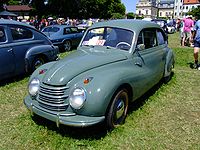
Ingolstadt
Ingolstadt is a city in the Free State of Bavaria, in the Federal Republic of Germany. It is located along the banks of the Danube River, in the center of Bavaria. As at 31 March 2011, Ingolstadt had 125.407 residents...
, Bavaria
Bavaria
Bavaria, formally the Free State of Bavaria is a state of Germany, located in the southeast of Germany. With an area of , it is the largest state by area, forming almost 20% of the total land area of Germany...
with loans from the Bavarian state government and Marshall Plan
Marshall Plan
The Marshall Plan was the large-scale American program to aid Europe where the United States gave monetary support to help rebuild European economies after the end of World War II in order to combat the spread of Soviet communism. The plan was in operation for four years beginning in April 1948...
aid.
The reformed company was launched on September 3, 1949. Only the DKW brand survived in postwar West Germany
West Germany
West Germany is the common English, but not official, name for the Federal Republic of Germany or FRG in the period between its creation in May 1949 to German reunification on 3 October 1990....
, continuing DKW's tradition of producing front-wheel drive
Front-wheel drive
Front-wheel drive is a form of engine/transmission layout used in motor vehicles, where the engine drives the front wheels only. Most modern front-wheel drive vehicles feature a transverse engine, rather than the conventional longitudinal engine arrangement generally found in rear-wheel drive and...
vehicles with two-stroke engines. This included production of a small but sturdy 125 cc motorcycle
Motorcycle
A motorcycle is a single-track, two-wheeled motor vehicle. Motorcycles vary considerably depending on the task for which they are designed, such as long distance travel, navigating congested urban traffic, cruising, sport and racing, or off-road conditions.Motorcycles are one of the most...
and a DKW delivery van, the DKW F89
DKW F89
The DKW Meisterklasse also known as the DKW F89 was a compact front wheel drive saloon manufactured by Auto Union AG between 1950 and 1954...
, also known as DKW-Schnelllaster. Many employees of the destroyed factories in Zwickau
Zwickau
Zwickau in Germany, former seat of the government of the south-western region of the Free State of Saxony, belongs to an industrial and economical core region. Nowadays it is the capital city of the district of Zwickau...
came to Ingolstadt and restarted the production.
In 1950, after a former Rheinmetall
Rheinmetall
Rheinmetall AG is a German automotive and defence company with factories in Düsseldorf, Kassel and Unterlüß. The company has a long tradition of making guns and artillery pieces...
gun factory in Düsseldorf
Düsseldorf
Düsseldorf is the capital city of the German state of North Rhine-Westphalia and centre of the Rhine-Ruhr metropolitan region.Düsseldorf is an important international business and financial centre and renowned for its fashion and trade fairs. Located centrally within the European Megalopolis, the...
was established as a second assembly facility, the company's first post-war car went into production: the DKW Meisterklasse F 89 P
DKW F89
The DKW Meisterklasse also known as the DKW F89 was a compact front wheel drive saloon manufactured by Auto Union AG between 1950 and 1954...
, available as a saloon and a four-seater Karmann convertible. The van and sedan were based on the DKW F8
DKW F8
The DKW F8 compact front-wheel drive two-stroke engined saloon was introduced by in 1939. The F8 was slightly shorter than its predecessor despite having a marginally increased wheelbase. The base model, known as the Reichsklasse, was manufactured only till 1940 but the Meisterklasse sedan...
and the DKW F9
DKW F9
The DKW F9 was the prototype of a car Auto Union intended to launch as a successor to the DKW F8.The small DKWs were among top selling small cars in Germany in the 1930s, and regular model updates were part of the company's strategy for maintaining commercial success in this growing market sector...
pre-war constructions.
.jpg)
Auto Union 1000
The Auto Union 1000 was a compact front wheel drive saloon manufactured by Auto Union AG between 1958 and 1963. It was the first model branded as an Auto Union by the manufacturer since the 1930s: it replaced the paradoxically named DKW 3=6, although the latter continued in production,...
, a small saloon. At the same time the Auto Union 1000 Sp
Auto Union 1000
The Auto Union 1000 was a compact front wheel drive saloon manufactured by Auto Union AG between 1958 and 1963. It was the first model branded as an Auto Union by the manufacturer since the 1930s: it replaced the paradoxically named DKW 3=6, although the latter continued in production,...
, a stylish coupé model, was produced for Auto Union by the Stuttgart
Stuttgart
Stuttgart is the capital of the state of Baden-Württemberg in southern Germany. The sixth-largest city in Germany, Stuttgart has a population of 600,038 while the metropolitan area has a population of 5.3 million ....
coach builders, Baur
Karosserie Baur
Baur is a Karosserie or coachbuilder in Stuttgart, Germany, which has been building BMW convertibles since the 1930s. Currently, they are the body and assembly works for IVM Automotive, a member the Ed Group...
. Secondly, Daimler-Benz
Daimler-Benz
Daimler-Benz AG was a German manufacturer of automobiles, motor vehicles, and internal combustion engines; founded in 1926. An Agreement of Mutual Interest - which was valid until year 2000 - was signed on 1 May 1924 between Karl Benz's Benz & Cie., and Daimler Motoren Gesellschaft, which had...
acquired 87% of Auto Union, taking complete control in 1959. The production of DKW motorcycles and two-stroke engines ended almost immediately under Daimler-Benz ownership, who invested heavily in the Ingolstadt plant for Auto Union production, one of the first products of the merged company being the DKW F102
DKW F102
The DKW F102 is a car that was produced initially by German manufacturer Auto Union AG and later by Volkswagen AG after Volkswagen acquired the Auto Union brands from Daimler-Benz AG in 1964. It succeeded the Auto Union 1000 and 1000S models in 1963...
series, which used a Mercedes engine. Auto Union production at Düsseldorf was ended and the plant became the centre of production for Mercedes-Benz commercial vehicles - a role which it continues to the present day.
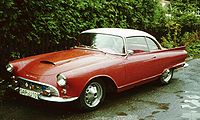
Volkswagen
Volkswagen is a German automobile manufacturer and is the original and biggest-selling marque of the Volkswagen Group, which now also owns the Audi, Bentley, Bugatti, Lamborghini, SEAT, and Škoda marques and the truck manufacturer Scania.Volkswagen means "people's car" in German, where it is...
.
In 1964, Volkswagen acquired the factory in Ingolstadt and the trademark rights of Auto Union. A programme that Daimler had initiated at Auto Union created a range of cars that would subsequently provide the basis for Volkswagen
Volkswagen
Volkswagen is a German automobile manufacturer and is the original and biggest-selling marque of the Volkswagen Group, which now also owns the Audi, Bentley, Bugatti, Lamborghini, SEAT, and Škoda marques and the truck manufacturer Scania.Volkswagen means "people's car" in German, where it is...
's line of front-wheel drive models such as the Audi 80
Audi 80
The Audi 80 is a compact executive car produced by the German car manufacturer Audi, from 1966 to 1996. It shared its platform with the Volkswagen Passat from 1973 to 1986 and was available as a saloon car/sedan, and an Avant...
and Volkswagen Passat
Volkswagen Passat
The Volkswagen Passat is a large family car marketed by Volkswagen Passenger Cars through six design generations since 1973. Between the Volkswagen Golf / Volkswagen Jetta and the Volkswagen Phaeton in the current Volkswagen line-up, the Passat and its derivatives have been badged variously as...
. At the time a new model, internally designated F103
Audi F103
F103 is the internal designation for a series of car models produced by Auto Union in West Germany from 1965 to 1972, derived from the earlier DKW F102...
, was under development. This was based on the last DKW model, the DKW F102
DKW F102
The DKW F102 is a car that was produced initially by German manufacturer Auto Union AG and later by Volkswagen AG after Volkswagen acquired the Auto Union brands from Daimler-Benz AG in 1964. It succeeded the Auto Union 1000 and 1000S models in 1963...
, with a four-stroke engine implanted and some front and rear styling changes. Volkswagen abandoned the DKW brand because of association with two-stroke engines, effectively leaving Volkswagen with the Audi brand. The new model was launched in September 1965 as simply the "Audi." The name was a model designation rather than the manufacturer, which was still officially Auto Union. As more models were later added to the Audi range, this model was renamed Audi 72.
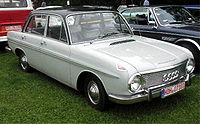
NSU Motorenwerke AG
NSU Motorenwerke AG, normally just NSU, was a German manufacturer of automobiles, motorcycles and pedal cycles, founded in 1873. It was acquired by Volkswagen Group in 1969...
, based in Neckarsulm
Neckarsulm
Neckarsulm is a city in northern Baden-Württemberg, Germany, near Stuttgart, and part of the district Heilbronn. As of 2004, Neckarsulm had 27,296 inhabitants....
, near Stuttgart
Stuttgart
Stuttgart is the capital of the state of Baden-Württemberg in southern Germany. The sixth-largest city in Germany, Stuttgart has a population of 600,038 while the metropolitan area has a population of 5.3 million ....
. In the 1950s, NSU had been the world's largest manufacturer of motorcycle
Motorcycle
A motorcycle is a single-track, two-wheeled motor vehicle. Motorcycles vary considerably depending on the task for which they are designed, such as long distance travel, navigating congested urban traffic, cruising, sport and racing, or off-road conditions.Motorcycles are one of the most...
s, but had moved on to produce small cars like the NSU Prinz
NSU Prinz
The NSU Prinz is an automobile produced in West Germany by the NSU Motorenwerke AG. The car was built from 1957 to 1973, and received a model change in 1961 .-NSU Prinz 30:...
, the TT and TTS versions of which are still popular as vintage race cars. NSU then focused on new rotary engines based on the ideas of Felix Wankel
Felix Wankel
Felix Heinrich Wankel was a German mechanical engineer and inventor after whom the Wankel engine was named. He is the only twentieth century engineer to have designed an internal combustion engine which went into production.-Early life:Wankel was born in Lahr, Baden, in the upper Rhine Valley...
. In 1967, the new NSU Ro 80
NSU Ro 80
The NSU Ro 80 was a technologically advanced large sedan-type automobile produced by the German firm of NSU from 1967 until 1977. Most notable was the powertrain; a , 995 cc twin-rotor Wankel engine driving the front wheels through a semi-automatic transmission employing an innovative vacuum system...
was a space-age car, well ahead of its time in technical details such as aerodynamics, light weight, and safety but teething problems with the rotary engines put an end to the independence of NSU. The mid-sized car NSU had been working on, the K70, was intended to slot between the rear-engined Prinz models and the futuristic NSU Ro 80
NSU Ro 80
The NSU Ro 80 was a technologically advanced large sedan-type automobile produced by the German firm of NSU from 1967 until 1977. Most notable was the powertrain; a , 995 cc twin-rotor Wankel engine driving the front wheels through a semi-automatic transmission employing an innovative vacuum system...
. However, Volkswagen took the K70 for its own range, spelling the end of NSU as a separate brand.
After being merged with Neckarsulm car maker NSU Motorenwerke AG
NSU Motorenwerke AG
NSU Motorenwerke AG, normally just NSU, was a German manufacturer of automobiles, motorcycles and pedal cycles, founded in 1873. It was acquired by Volkswagen Group in 1969...
the official name was "Audi NSU Auto-Union AG", which was simply shortened to "Audi AG" in 1985, ending Auto Union.
In May 2009, as Porsche gained majority control of Volkswagen Group and proposed a merger of the two companies. In August 2009, Volkswagen AG's supervisory board signed the agreement to create an integrated Auto group with Porsche led by Volkswagen. Volkswagen will initially take a 42% stake in Porsche AG by the end of 2009 and it will see the family shareholders selling the automotive trading business of Porsche Holding Salsburg to Volkswagen. Rumors began to appear in the press the name Auto Union would be revived for the new group holding company.
Logo
The trademarkTrademark
A trademark, trade mark, or trade-mark is a distinctive sign or indicator used by an individual, business organization, or other legal entity to identify that the products or services to consumers with which the trademark appears originate from a unique source, and to distinguish its products or...
symbol of Auto Union, the four overlapping rings, symbolized the four member companies represented the four marques of Auto Union: Audi, DKW, Horch and Wanderer.
Although Auto Union used the four ring logo, it was only used on Auto Union racing car
Auto Union racing car
The Auto Union Grand Prix racing cars types A to D, were developed and built by a specialist racing department of Horch works in Zwickau between 1933 and 1939....
s in that period, while the member companies used their own names and emblems.
There is also a version of logo that uses both overlapping and interlocking rings.

